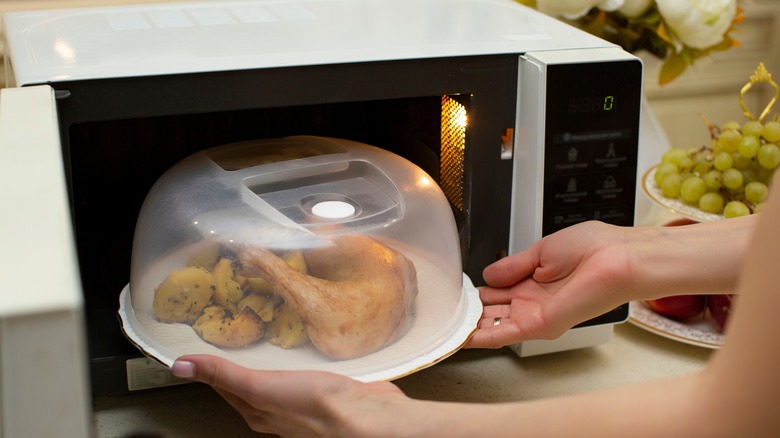It goes without saying that the only things you should really put in your microwave are food, liquids and food-safe containers, but it can be hard to determine whether something is truly microwave-safe. This guide can help you identify containers that are microwave-friendly to help you serve the tasty meals at your family’s table.

What can’t you put in the microwave?
While there are plenty of things that can go in your microwave, there are also many things that can’t. It’s best to keep the following materials out of the microwave and transfer any food or liquid from these containers to microwave-safe varieties.
Some types of Styrofoam are safe to microwave, but they must be labeled as such. If you don’t see a microwave-safe label or aren’t sure what type of Styrofoam you’re using, it’s best to keep it out of the microwave.
If you can microwave paper plates and towels, can you do the same with cardboard? Both are paper products, after all. Unfortunately, cardboard can contain glues, waxes and other materials that can make it a safety hazard in the microwave. Some cardboard takeout boxes even have metal handles or fasteners that can cause sparks and present a fire hazard. Keep your microwave (and your family) safe by removing food from cardboard containers and placing them on microwaveable plates or in microwave-safe bowls.
Metals including stainless steel and aluminum foil
Anything made of or containing steel, iron, copper or other hard metals should never go in your microwave. Metal surfaces reflect microwaves, which increases the heat inside the appliance and could lead to a fire. If you’re storing leftovers in a metal container, remove the food and place it in a microwave-safe container instead.
When it comes to aluminum foil, things can get tricky. Technically foil can be microwaved, but its surface needs to stay as flat as possible. Wrinkles or crumpled foil can cause “arcing”—that is, it can cause electric sparks to shoot across the surface of the foil, potentially damaging your microwave or causing a fire. In addition, food wrapped in aluminum foil may not cook or reheat properly in the microwave—the foil will reflect the radio waves instead. Each microwave is different, learn more about how a microwave works or consult your owner’s manual to determine if aluminum foil is safe. And when in doubt, avoid placing any kind of metal in your microwave.
Use Microwave Covers to cover food
How do you cover food in the microwave?
There are a few different ways to cover food in the microwave. One way is to use a microwave-safe dish with a lid. Another way is to use a microwave-safe plastic wrap. If you don’t have either of these, you can also use a plate or a bowl to cover your food. Just make sure that whatever you use to cover your food is microwave-safe.
Should you cover a microwave plate when reheating?
Lightly covering your food while reheating it in the microwave keeps the steam close to your food ensuring that the dish reheats evenly, as it help retaining the moisture. So, it is better to reheat food covered as the food tastes better. Are Plastic Microwave Plate Covers Safe? According to recent studies, they are not.
Do you need a plastic cover for a microwave?
You can buy a domed or flat plastic cover that sits over your dish of food. The reusable cover is easy to wash and prevents food from splattering against the microwave’s sides and turntable. Since the cover should be larger than your dish, you don’t have to worry about the plastic touching your food.
Do you need a cover for microwave cooking?
In addition to using a cover, tips for microwave cooking include stirring about halfway through, heating to a minimum of 75 degrees, and letting food steam or come to a boil to kill bacteria. We all hate opening the microwave to find a splattered mess clinging to corners and crevices. Here’s why you should always cover your food.
